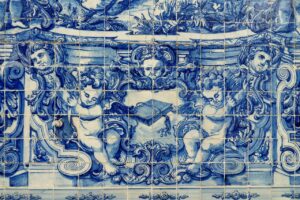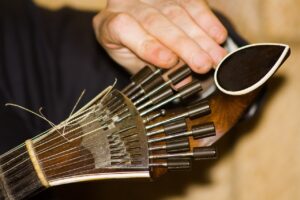Lesser-known face of Lisbon – top language holiday destination in Portugal
Discover Lisbon: Street Art, Museums, and a Hidden Paradise
We present you Lisbon seen with a brand new eye: its vibrant street art, our favourite museums, and a secret paradise just half an hour from the city. A breath-taking destination for your Portuguese course!
Lisbon Beyond the Classics
What picture comes to mind when thinking of Lisbon? Perhaps yellow trams winding through narrow streets, the taste of pasteis de nata, or the red rooftops of white buildings seen from the city’s viewpoints? While these are iconic symbols, the city of seven hills offers so much more.
Street Art – Explore, Spot, and Be Inspired
Wandering through Lisbon’s heart can lead to unexpected surprises, thanks to its omnipresent street art.
A must-see is the area around São Jorge Castle. Here, a stroll will reveal one of the most captivating street art displays: the portrayal of Fado vadio on a series of facades. Located near the Mouraria and Alfama neighborhoods, the birthplace of this UNESCO World Heritage song, it’s a natural choice for this artistic homage.
Another fantastic spot is near Marquês de Pombal, where two of our Portuguese language schools are located. You’ll find three striking buildings adorned with large murals that breathe new life into the area. The iconic Marquês de Pombal roundabout, which marks km 0 of Lisbon, is the meeting point of the city’s main avenues. Our schools are just five minutes away, making these incredible works of street art unmissable. They will surely make you pause and admire!
Lisbon’s Market and Mural Marvels
Whether you enjoy flea markets or not, a visit to the Feira da Ladra is worth your time. Held on Tuesdays and Saturdays, this “thief market” is set in a vibrant area filled with character. On your way, you’ll encounter one of Lisbon’s most recent artistic masterpieces: a stunning tile mural by André Saraiva. This 188-meter-long mural, made from over 52,000 ceramic tiles, showcases a beautiful connection between Lisbon and Paris.
Other districts such as Graça, Belém, and Mouraria are also home to mesmerizing street art, adding to the city’s magical allure. So, enjoy your stroll and soak in the urban beauty that makes Lisbon unique!
Iberica Languages’ favourite spots: that is 2 museums that can’t be missed!
 Museu do Azulejo
Museu do Azulejo
Some of the bloggers call it a hidden gem, but it’s no longer that unknown. The Azulejo National Museum is located in the old convent of Madre de Deus. The museum collection features decorative ceramic tiles or azulejos from the second half of the 15th century to the present day. You can understand the evolution of tile in Portugal throughout history as well as admire some of the finest examples of tiles from different centuries, including the fantastic church inside. The museum has a lovely green terrace and a restaurant. If you are a fan of Portuguese tiles, you should also try street tile hunting in the districts of Alfama, Baixa, Chiado, and Principe Real; success is guaranteed!
 Museu do Fado
Museu do Fado
Inscribed in 2011 on the list of the Intangible Cultural Heritage of Humanity by UNESCO, Fado is a symbol of identity, it represents a distinctly Portuguese multicultural synthesis of various music genres, starting from Afro-Brazilian roots, local urban song patterns as well as rural music of the early nineteenth century.
Immerse yourself in the bittersweet melodies at the Fado Museum. This engaging venue traces fado’s history from its working-class roots to its international fame. Entirely devoted to Lisbon’s urban song, it was opened in 1998, highlighting Fado’s exceptional value and its deep roots in the tradition and cultural history of the city of Lisbon and the entire country, as well as its role in the Portuguese cultural and national identity statement.
There are plenty of other museums that are maybe lesser-known but definitely worth visiting like Money Museum, Water Museum, Carris Tram Museum, and Electricity Museum.
 Secret paradise near Lisbon: Arrábida
Secret paradise near Lisbon: Arrábida
You probably heard of the nearby famous towns of Sintra and Cascais. Both are charming, yet often visited and packed with tourists at some points of the year. If you want to escape from the city and look for a stunning yet calm and not so crowded place, then Park of Arrábida (Portuguese: Parque Natural da Arrábida) is your place to go! Less than one hour south of Lisbon, the park offers breathtaking coastal scenery, where the blue of the sea alternates with the white tones of the chalk cliffs and the depths of the green vegetation that covers the mountain range. The highest point is in the Serra do Risco, a magnificent cliff 380m high. Good ways of getting to know this pristine place are by hiking or cycling the waymarked footpaths. Portinho da Arrábida is considered one of the most beautiful villages in Portugal and also one of the most beautiful beaches; it is a place with unique flora and fauna to be discovered in the clear waters.
All we mentioned above, the urban street art, museums, and a stunning natural park just next to the city adds to Lisbon’s well-known hot spots and well-established routes. One of the best times to visit Lisbon is early June, when all the city celebrated the festival of its patron saint, Santo Antonio. The official celebration takes place on June 12th and the preceding night, but during the whole month you will see streets dressed up in colourful decorations, sardines being grilled in every square, and happy inhabitants of Lisbon dancing, singing, and enjoying life in one of the most delightful cities in the world.


